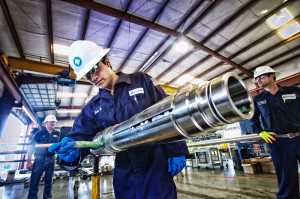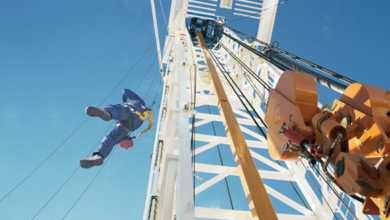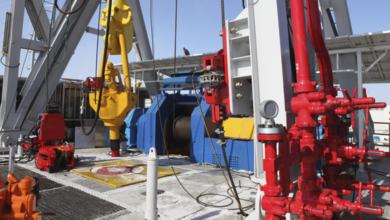Drilling & Completion Tech Digest
Project 20K reaches milestone with orders for BOPs, risers
Maersk Drilling has placed an order with GE Oil & Gas for the industry’s first 20,000-psi rated deepwater BOP and riser systems. The order, which is subject to a final investment decision between Maersk and BP, is part of Project 20K, which was announced in 2013.
The two companies are jointly developing conceptual engineering designs for an advanced-technology rig that can safely and efficiently operate in high-pressure and high-temperature reservoirs up to 20,000 psi and 350°F.
“This is a key milestone in the progression of BP’s delivery of Project 20K technologies and supports our industry relationships toward the delivery of standard industry solutions,” Gary Jones, VP of BP’s Global Wells Organization, said.
The equipment – four BOPs and two risers – is targeted for two Maersk Drilling 20K rigs. “With the order of the blowout preventers, we are passing a key milestone in the development of a truly purpose-built 20K rig,” Claus Hemmingsen, Maersk Drilling CEO and a member of the Maersk Group Executive Board, said.
“This project has been a unique opportunity to work closely with BP and co-create a new rig design that is safe and efficient and technologically best-in-class. The intention and our expectation is to see a 20K rig contract realized next year.”
A jointly staffed engineering team in Houston, with support from Maersk’s headquarters in Copenhagen, has been working on the engineering studies required to select the design of the 20K rig, riser and BOPs. BP has estimated that application of this technology across its global portfolio could access an additional 10-20 billion barrels of resources.
GE will design, test and manufacture the 20,000-psi BOPs and risers at its technology center in Houston. The equipment is due to enter service in 2018.
20K is a trademark of BP.

10,000-psi, 25-in. OD riser run in North Sea
Aquaterra Energy has completed the world’s first installation and retrieval of a 10,000-psi rated, 25-in. OD full-bore riser, the company announced.
Apache North Sea required a high-pressure riser system that would allow three subsea wells to be drilled safely on the Bacchus field in the North Sea from the Rowan Gorilla VII jackup.
Building on Aquaterra Energy’s 5,000-psi riser system, the company developed a 10,000-psi system in collaboration with Oil States Industries, using its Merlin connectors, which had not been used at high pressures for this particular application before.
Mapping the future to 2025: Drilling system automatically executes well plan, completion
A group of multidisciplinary experts from inside and outside the drilling industry have banded together to develop a roadmap for drilling systems automation (DSA). The DSA Roadmap Cross Industry Initiative recognizes the need for DSA and the direction – a roadmap – to reach the destination. “You can’t develop it step by step. You need a roadmap to get from here to where our future is going to be,” John de Wardt, DE WARDT AND COMPANY, stated at the 2014 IADC DSA Roadmap Workshop on 17 June in Vienna. During the workshop, Mr de Wardt shared the group’s ongoing work, and attendees discussed various automation challenges and provided feedback.
DSA aims to be a step-change innovation that will require a significant departure from business as usual. “It’s high risk, and it’s high technology. This has a critical part in enabling big value creation,” Mr de Wardt said. The vision behind the DSA initiative originated in 2012 at a multidisciplinary Drilling Systems Automation workshop.
The scope of the DSA roadmap is intended to cover the full drilling and completion cycle – from spud to the well going on stream.
Downhole video technology center opens in UK
EV, a UK-based downhole video technology specialist, has opened the world’s first technology center dedicated to downhole video. The center in Norwich will facilitate all of the company’s ongoing research and development.
The 23,000-sq-ft facility will provide warehouse space, as well as a lab that has the ability to test camera technology in environments up to 347°F and 20,000 psi.

Reservoir mapping-while-drilling enables precise well landing
In the North Sea, a mapping-while-drilling service was used to land a well and detect the top of the reservoir target from nearly 50 ft away.
This allowed the team to optimize the drilling plan before drilling into the formation. With the bit more than 300 ft from the target reservoir, Schlumberger’s GeoSphere service confirmed there was considerable distance for adjusting the trajectory to optimize reservoir entry.
The service can reveal features in subsurface beddings and fluid contacts at the reservoir scale to optimize well landing operations and steering capabilities.
It also improves mapping of multiple boundaries using deep directional resistivity measurements enabled by proprietary real-time interpretation techniques.
Using its deep range of investigation that extends more than 100 ft from the wellbore, drilling teams can reduce drilling risk and accurately land wells, resulting in the elimination of pilot holes.
The service has been tested in more than 140 wells worldwide, including locations in North America, South America, Europe, Middle East, Russia and Australia.

Expro deploys new DST tool in Gulf of Mexico
Expro has deployed the new-design ExACT (Expro Annulus-Operated Circulating and Test Tool) in a live offshore well in the Vermillion field in the Gulf of Mexico.
This deployment, a tubing-conveyed perforating “shoot and pull,” follows trial work onshore Brazil last year.
This drillstem testing (DST) tool combines downhole shut-in and circulating functionality. Rated for 15,000 psi and 400˚F, ExACT features minimal fast cycling to position the ball and ports, shortening times between cycles.
DNV GL proposes JIP for offshore power using batteries
DNV GL has proposed a joint-industry project (JIP) for a hybrid-power concept for offshore units using batteries in combination with traditional power-generation equipment.
The concept has delivered multiple advantages in the maritime and automotive industries but has not yet been applied in the oil and gas industry.
The maritime industry started to adopt this technology five years ago because of the environmental benefits and for enhanced financial and performance benefits.
In some maritime applications, there has been up to a 40% saving, and DNV GL said it expects to see the same for the oil and gas industry.
Currently, there are 17 hybrid ships either in operation or being built, plus one electric ferry. DNV GL studies show that the payback period is approximately two years for the maritime application.
The reduced size of the power generator is a major advantage with a hybrid approach.
Three gas turbine generator sets, plus a spare for redundancy, typically power a conventional offshore facility. The total installed power is dimensioned according to peak power requirements but is normally operated at a lower power level.
Record 92 –sleeve fracturing completed in Eagle Ford well
NCS Energy Services, an independent technology and services company specializing in multistage completions, has completed fracturing operations on an Eagle Ford well that incorporated 92 Multistage Unlimited cemented casing sleeves.
According to the company, this is a world record number of sleeves in a single completion.
NCS teamed with a coiled-tubing and frac-pumping service company to perform the frac operations using the NCS Multistage Unlimited re-settable frac-isolation system, deployed on coiled tubing.
The system required no frac plugs to pump down and no balls to drop. At one point, the company stated, 20 stages were completed in 24 hours, and many stages were completed in less than 1 hour per stage.
The NCS frac-isolation assembly completed the final 80 stages in a single trip. Overall, almost 6 million lb of proppant were placed in precisely positioned fracs. The NCS Multistage Unlimited system was introduced in 2011; since then, more than 40,000 cemented casing sleeves have been installed and fracked.
More articles about industry technology milestones and downhole and subsea innovations are available on DC’s Innovating While Drilling microsite. Click here to visit the site.



